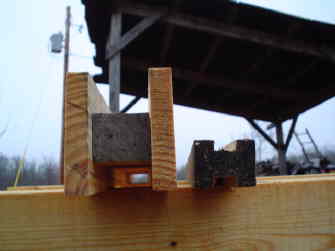Bandmill Blade Roller Guide Settings
Maintain a downward pressure, or leave a slight clearance? October 28, 2008
Question
How many of you guys run your blade guide rollers with down pressure on the blade? My instruction manual said to keep a few thousandths space between the roller and the blade. I talked with Cooks on the phone and they say to push that blade down a quarter of an inch with the roller guides. I think I will start out with an eighth of an inch but I have to wait a couple days before I can try it. Just wondering how other guys adjust their guides. Maybe this is what has been causing me so much trouble.
Forum Responses
(Sawing and Drying Forum)
From contributor B:
I run my blade guides at 1/4" below the band wheels. That seems to work best for my Breezewood mill.
From contributor S:
1/4" downpressure here.
From contributor N:
I running about 1/4 inch on my Timberking 1600. I also installed Cook roller guides. This has improved my blade life.
From contributor O:
Typically on my manual mill, I can count on around 600 Bd. Ft. using Lenox Woodmaster C bands. As far as blade guides, My mill (TA Schmid) runs around 1/8-1/4" down pressure on the guides.
You mentioned thick and thin lumber. Whenever I saw ash, I must be careful because of the stresses in the trees. I square up and then saw through-and-through, going from top down, without removing the boards. This method keeps the weight on the cant and it doesn't move so much. Not the greatest technique, but it works.
From contributor S:
It's hard to believe they would recommend clearance between the blade and guides - may as well not have guides. Seems like the more down pressure the better control of the blade. I run 1/4" also and tried 1/2" once but started breaking blades way to fast. It must have been to sharp of a bend around the guide wheels.
From contributor R:
I've never run any saw with pressure on the blade from the guides, and haven't heard of anyone doing so until now. I've been taught and have had great success maintaining the slightest clearance between the band and the guide. I've setup, maintained, and operated re-saws running blades from 1 to 8" in width and always kept this clearance. Running with a downward pressure is just creating another point of friction in the travel of the blade. Putting this pressure on the blade would mask tracking, lead, or tension problems by redirecting the blade travel. It might work, but doesn't sound like a good long term solution.
From contributor E:
This is the first time I am hearing about the blade not touching the guide. Why have a guide at all much less being able to adjust it in and out?
From contributor H:
Contributor R, down pressure would be with roller guides so there wouldn't be any friction problem. Friction guides would need to be run with some clearance.
From contributor R:
I'm with you on the roller guides - would not be a lot of friction.
Contributor E - in my opinion, you have guides in place to keep the blade in its designed plane of travel. It should run and cut in that plane normally, but may wander if there is an unusual amount of stress. Just to try it out, I've sawn a couple logs on a new saw with the guides off the machine - no problems until the saw started to dull.
I'm not dismissing the practice all together. I know it's not for me though, especially since I don't run roller guides. I'd like to hear more from people that do this. Will the saw track correctly on both wheels without guides on the machine? Does the saw have any lead without guides on the machine? Does the saw have any lead with the guides adjusted to press the saw down (are you pressing down parallel to the bed, or are you creating lead with the guides)?
From contributor A:
The roller guides of small bandmills need to have 1/8" to 1/4" down Deflection. The blade should track about 1/16" to 1/8" off the back of the roller guide and the roller should be cocked about 1/32 of an inch from the front of the blade to the incoming side of the blade travel. The tilt of the blade to the deck should be measured and be within level as you can make it, with 1/32 of an inch with an 18 inch bar being max. If you have a pad under the roller you should just be able to insert a business card when the blade is on and under tension.
From contributor G:
Without getting too technical, I think the rollers with downward pressure ensure good vibration damping. If the roller is at the blade height a vibration wave can skip past the roller and continue to the other side. I think this is mostly applicable for the times the blade is not in the log. The log should dampen vibrations too.
From contributor D:
I think what makes this information challenging is that there are differences in these bandmills. Some have steel wheels, top only guides, rollers guides, slides. The distance between the wheels is different too. A quarter inch may not be a lot for some size mills. Blade vibration may be an issue with some saw configuration, the deflection would help.
